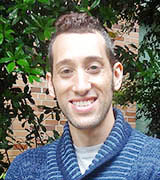Colleagues: Recently Tenured
ELODIE GHEDIN, PH.D., NIAID
Senior Investigator and Chief, Systems Genomics Section, Laboratory of Parasitic Diseases, National Institute of Allergy and Infectious Diseases

Education: McGill University, Montreal, Canada (B.S.in biology; Ph.D. in molecular parasitology); University of Quebec, Montreal, Canada (M.S. in environmental sciences)
Training: Postdoctoral fellow, Laboratory of Parasitic Diseases, NIAID; postdoctoral fellow, The Institute for Genomic Research (Rockville, Maryland)
Before returning to NIH: Director, Center for Genomics & Systems Biology, New York University (NYU; New York)
Returned to NIH: In 2020
Outside interests: Cartooning; playing the flute; binge-watching Netflix series
Website: https://irp.nih.gov/pi/elodie-ghedin
Research interests: I am a parasitologist, with expertise in pathogen genomics, specializing in computational and systems biology. My lab and I are studying the parasites and microbes underlying infectious diseases worldwide for the purpose of developing and applying new methodologies to combat these pathogens. In particular, we are focusing on the molecular basis of macroparasite (nematodes) adaptation to niches in their human hosts, and microparasite (virus and bacteria) diversity and interaction in transmission and virulence.
The remarkable persistence of parasitic nematodes, such as Brugia malayi (which causes lymphatic filariasis, or elephantiasis) and Onchocerca volvulus (which causes river blindness), in chronic human infections suggests the evolution of strategies to regulate and evade host immunity. These organisms may represent a tremendous reservoir of untapped molecules that could be exploited for treating human inflammatory and autoimmune diseases.
In my previous research, my collaborators and I discovered that male worms secrete novel acetylcholine analogs that inhibit the acetylcholine receptor. At NIH, we are testing synthesized versions of these compounds on the cholinergic system of immune cells.
We use a systems-biology approach to understand pathogenesis in severe influenza infection and in COVID-19. We are using new analytical tools to define the genetic structure and mechanisms of evolutionary change in influenza virus and SARS-CoV-2 (the virus that causes COVID-19) within individual hosts over the course of an infection and across chains of transmission. At NYU, I observed that the dynamics of influenza virus evolution are different in high-risk populations such as immunocompromised and obese individuals. At NIH, we are exploring that aspect using an obese ferret model.
I also helped identify several key regulators involved in the host response to influenza virus and bacterial infections, and in host-gene pathways associated with specific antibiotic-resistance genes. At NIH, I will be continuing to explore how the respiratory tract is a potentially important reservoir of antibiotic resistance genes in humans.
MARKUS HAFNER, PH.D., NIAMS
Senior Investigator and Chief, RNA Molecular Biology Group, Laboratory of Muscle Stem Cells and Gene Regulation, National Institute of Arthritis and Musculoskeletal and Skin Diseases

Education: University of Bonn, Bonn, Germany (M.Sc. equivalent in chemistry; Ph.D. in biochemistry)
Training: Postdoctoral fellow, Rockefeller University (New York)
Came to NIH: In 2014 as an Earl Stadtman Investigator in NIAMS
Outside interests: Playing with his three-year-old daughter; cooking; not getting enough exercise; and looking forward to going on the next road trip with his family
Website: https://irp.nih.gov/pi/markus-hafner
Research interests: In the RNA Molecular Biology Group, we are studying the impact of RNA-binding proteins (RBPs) on the fate of bound RNA molecules. RBPs are key regulators of posttranscriptional gene expression and control many important biological processes including cell proliferation, development, and differentiation. When RNA regulation goes wrong, the consequences can be devastating and include a wide range of disorders such as cancer, sterility, muscular dystrophy, and many neurological diseases.
We are using large-scale quantitative methods, such as next-generation sequencing and modern mass spectrometry, to determine the functional impact of RBPs on a systems-wide level. Integration of these large-scale datasets allows us to elucidate the function and molecular mechanisms of RNA-binding proteins involved in RNA transport, RNA stability and turnover, and RNA translation.
One recent example that illustrates our approach to dissecting posttranscriptional gene regulatory networks is our study of the RNA-binding protein Dead-end 1 (DND1), which is known to play a role in the development and maintenance of the germline. We found that DND1 may be necessary for the clearance of unwanted RNA in the cells, and that it binds to specific sequences on RNA and recruits molecular machinery that degrades RNA. Mice lacking DND1 develop testicular germ-cell tumors and are sterile. By studying the protein, we think we’ve found the molecular mechanisms underlying testicular cancer and sterility.
We are also investigating the role of predicted adenylate-uridylate-rich element-binding proteins in determining messenger RNA (mRNA) turnover; identifying and characterizing the interaction network of mRNA binding transport and shuttling proteins and their RNA targets at a sequence and functional level; investigating the impact of select RBPs on translation initiation and elongation; and integrating the results from our systems-level determination of cis-acting elements (certain DNA sequences) into high-resolution maps of posttranscriptional regulatory events.
MICHAEL J. KRASHES, PH.D., NIDDK
Senior Investigator and Chief, Section of Motivational Processes Underlying Appetite, Diabetes, Endocrinology, and Obesity Branch, National Institute of Diabetes and Digestive and Kidney Diseases

Education: Boston College, Newton, Massachusetts (B.A. in biology); University of Massachusetts Medical School, Worcester, Massachusetts (Ph.D. in neuroscience)
Training: Postdoctoral fellow, Beth Israel Deaconess Medical Center, Harvard Medical School (Boston)
Came to NIH: In 2013 as a tenure-track investigator
Outside interests: Hiking; running; playing video games; watching trashy reality TV shows
Website: https://irp.nih.gov/pi/michael-krashes
Research interests: The ultimate goal of my research is to decipher the brain circuits that underlie hunger. My lab and I are using novel genetic tools and techniques with the hopes of furthering our understanding of how the brain drives humans to obtain food and ultimately how these behaviors can be manipulated to battle obesity and eating disorders.
We are using a rodent model to understand how the brain controls feeding and eating patterns in the procurement of nutrients. We are studying how the brain brings together information sensed from its external environment and its own internal states, including memory, to guide this behavior. Much of our work focuses on the hypothalamus, which acts to integrate information related to hunger and directs the body toward caloric intake in times of need. We are particularly interested in how this signaling goes awry in models of obesity and in the presence of highly palatable diets such as those rich in fats.
We are currently determining how these diets affect the response of discrete groups of neurons in the brain to food and how these changes lead to the challenges of dieting.
In a recent paper, we highlighted the role of neurons in the paraventricular hypothalamus (PVH), which is critical for appetite regulation. We showed how certain PVH neurons orchestrate acute feeding behavior and demonstrated the indispensability of other PVH neuron types in the maintenance of body weight. (Cell Metab 29:681–694.e5, 2019; DOI:10.1016/j.cmet.2018.10.016)
P’NG LOKE, PH.D., NIAID
Senior Investigator and Chief, Type 2 Immunity Section, Laboratory of Parasitic Diseases, National Institute of Allergy and Infectious Diseases

Education: University of Oxford, Oxford, England (B.A. in biology); University of Edinburgh, Edinburgh, Scotland (Ph.D. in parasite immunology)
Training: Postdoctoral training in immunology, University of California, Berkeley (Berkeley, California); postdoctoral training in parasitology, University of California, San Francisco (San Francisco)
Before coming to NIH: Associate professor, Department of Microbiology, New York University (NYU) Grossman School of Medicine (New York)
Came to NIH: In 2020
Outside interests: Swimming; cycling; running; fixing bicycles
Website: https://www.niaid.nih.gov/research/png-loke-phd
Research interests: I am interested in how helminths (parasitic worms) regulate the host immune system. Scientists think that there could be a link between the eradication of helminth infections in developed countries and the epidemic of diseases associated with dysregulated inflammation (such as inflammatory bowel disease, allergy, asthma, and even metabolic diseases such as atherosclerosis and diabetes). One of the reasons I came to the NIH is to develop human challenge studies with these worms, as well as to do detailed immune profiling to better understand whether parasitic worms can be used to treat disease and the mechanisms behind it.
I became interested in this topic when I met and carefully characterized an individual who self-infected with whipworm and was able to put his ulcerative colitis into remission. Using mouse models and studying people in Malaysia, my lab at NYU found that whipworms can reverse dysbiosis (microbial imbalance) by altering the bacterial communities in the gut. However, I also know that there is a lot of interindividual variation in immune responses to these parasites. I am trying to understand the genetic and environmental contributions to immune variation between individuals.
I have also worked with collaborators at Princeton University (Princeton, New Jersey), studying mice in a semirural “re-wilding” facility. These mice had more and bigger intestinal worms than laboratory mice, an immune system that couldn’t fight off the worm infection, and a greater range of gut microbiota. Our study suggested that the environment may be the primary driver of the composition of the immune system, while genetics could be a stronger driver of per-cell responsiveness and cytokine production.
My NIH lab and I are also interested in the macrophages induced by these helminths, which have a tissue-repair phenotype termed M2 or are alternatively activated. With these macrophages, the cellular origin determines how they respond to cytokine activation. We are trying to understand the epigenetic and genetic basis for these differences in responsiveness, as well as the heterogeneity of cell states among these macrophages from different cellular lineages.
NIKI MOUTSOPOULOS, D.D.S., PH.D., NIDCR
Senior Clinical Investigator, Oral Immunity and Inflammation Section, National Institute of Dental and Craniofacial Research

Education: Aristotle University of Thessaloniki, Thessaloniki, Greece (D.D.S.); University of Maryland School of Dentistry, Baltimore, Maryland/National Institutes of Health (certificate in periodontics; Ph.D. in immunology)
Training: Intramural Research Trainee Award (IRTA), NIDCR; later became a research fellow and then a clinical fellow
Came to NIH: In 2007 for postdoctoral training; became an assistant clinical investigator in 2010
Outside interests: She is mother of two young children. Reading; cooking; traveling with her family.
Website: https://irp.nih.gov/pi/niki-moutsopoulos
Research interests: My lab’s focus is on oral mucosal immunity with an emphasis on aberrant inflammatory conditions of the oral cavity. Over the past few years I have established a bench-to-bedside research program that is aimed at understanding the molecular and cellular basis of oral mucosal immunity in health and in periodontitis, a common inflammatory disease that damages soft tissue in the mouth and can destroy the bone that supports teeth.
In health, the oral mucosal immune system maintains a delicate balance with a rich and diverse community of oral commensals and performs immune surveillance while preventing inflammation. We are interested in how host-microbial interactions preserve health as well as drive chronic inflammatory responses and tissue destruction in the oral cavity. We aim to define key pathways involved in susceptibility to and progression of aggressive forms of periodontitis. In so doing, we hope to identify therapeutic targets.
Our program implements a bench-to-bedside approach. We are leveraging the diverse strengths of the NIH intramural program and interrogating mechanisms involved in human oral immunity. We supplement this research using relevant animal models and novel immunologic techniques to study tissue immunity. We are working with patients who have rare monogenic immune disorders such as leukocyte adhesion deficiency 1 (LAD1).
LAD1 is associated with severe periodontal bone loss. In working with people who have this rare disorder as well as with people who have common forms of periodontitis, we have identified the upregulation of interleukin-23 and interleukin-17 (IL-23 and IL-17) as potential culprits and therapeutic targets in periodontitis. In fact, our basic research has led to translation into the clinic (in collaboration with Steve M. Holland’s group in NIAID), targeting the IL-23 response in patients with LAD1. (Sci Trans Med 6:229ra40, 2014; DOI:10.1126/scitranslmed.3007696; N Engl J Med 376:1141–1146, 2017; DOI:10.1056/NEJMoa1612197; Sci Trans Med 10:eaat0797, 2018; DOI:10.1126/scitranslmed.aat0797)
ARGYRIS STRINGARIS, M.D., PH.D., NIMH
Senior Investigator and Chief, Mood Brain and Development Section, Emotion and Development Branch, National Institute of Mental Health

Education: University of Göttingen in Göttingen, Germany (M.D.); King’s College London, London (Ph.D. in developmental neuroscience)
Training: Residency in neurology and medicine, University of Göttingen; higher specialist training in child and adolescent psychiatry, Maudsley Hospital (London); research fellow specializing in bipolar spectrum disorders, NIMH
Before returning to NIH: Senior lecturer (tenured), Institute of Psychiatry, King’s College London; attending physician, Department of Child and Adolescent Psychiatry, Maudsley Hospital
Came to NIH: In 2008–2009 for training; returned in 2016
Outside interests: Rowing (indoor mainly); studying philosophy; cooking
Website: https://irp.nih.gov/pi/argyrios-stringaris
Research interests: I am interested in how mood is generated and maintained and seek to use this knowledge to improve the treatment of young people with depression and related conditions. I use neuroimaging, epidemiology, and treatment studies (such as cognitive behavioral therapy and medication) to probe brain mechanisms involved in mood and emotion processing. I also have a special interest in reward processing and how it relates to patient’s feelings and decision making. A central part of my work is to improve the way we measure mood using multimethod and multisource approaches.
My lab and I did several studies that link depression to aberrant reward processing. In one study, we analyzed functional magnetic-resonance imaging and electroencephalogram studies and found that, when compared with healthy volunteers, depressed individuals showed reduced activation in the striatum, the area of the brain associated with reward responses. These differences may underlie the pathogenesis of depression and have important implications for the development of new treatments for depression. (Am J Psychiatry 175:111–1120, 2018; DOI:10.1176/appi.ajp.2018.17101124) [https://www.ncbi.nlm.nih.gov/pmc/articles/PMC6345602/]
In another study, we helped delineate the pathophysiological underpinnings of anhedonia (loss of interest in previously rewarding activities) in children. (JAMA Psych 76:624–633, 2019; DOI:10.1001/jamapsychiatry.2019.0020)
This page was last updated on Wednesday, March 23, 2022
